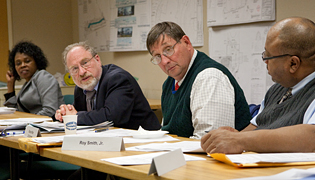
 Yale got provisional permission to build a bold new home for its School of Management —but only after it has the $145 million to pay for it.
Yale got provisional permission to build a bold new home for its School of Management —but only after it has the $145 million to pay for it.
The conditional OK came in the form of a vote Wednesday night’s monthly meeting of the City Plan Commission.
Commissioners voted to approve a Yale proposal to build a brand new School of Management (SOM) building at 155 – 181 Whitney Ave. The massive glass-and-steel edifice (pictured) — characterized as by some as airport-like—carries an estimated $145 million pricetag and is intended to be up by September 2013.
The SOM proposal now moves to the Board of Aldermen, which will hold a public hearing before voting on a final approval.
The building proposal was before the City Plan Commission because it entails the creation of a Planned Development District. A PDD is a powerful — and contentious—zoning tool that creates special permissions for individual large-scale building projects.
The City Plan Commission’s approval of the PDD application came with a number of conditions.
Among them was a requirement that Yale possess the funds needed to build the new building before it begins tearing down the existing two buildings at the site.
Commissioners further required that there be no more than 90 days between the completion of demolition and the commencement of construction, and that construction take a “reasonable” amount of time.
Commissioners said they were trying to avoid a situation in which Yale runs out of money mid-project and leaves a “hole” on Whitney Avenue.
The commission also included conditions that would require a redesign of the north side of the proposed building to create more room for pedestrians and cyclists, and 24/7 access to a foot and bicycle path from Pearl Street to Whitney Avenue. The commission suggested, but did not require, that the path be reconfigured for ease of biking and to increase late-night safety.
None of the commission’s conditions are binding. The Board of Aldermen makes the final call.
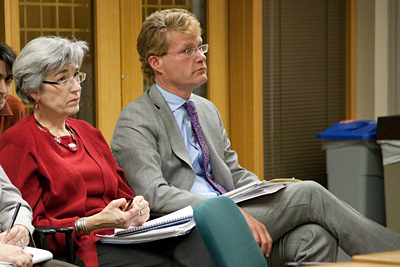 After the meeting, Yale Associate Vice President Michael Morand (at right in photo) said he is pleased by the commission’s decision. He expressed confidence that the project would meet the “spirit” of the board’s recommendations.
After the meeting, Yale Associate Vice President Michael Morand (at right in photo) said he is pleased by the commission’s decision. He expressed confidence that the project would meet the “spirit” of the board’s recommendations.
Several neighbors expressed disappointment with the commission’s decision and promised to continue to fight the plan.
Details And Reasons
At a public hearing at last month’s City Plan meeting, some neighbors spoke out against the plan. No further public input was allowed on Wednesday evening. Instead, commissioners heard from City Plan staff, who explained the details of the proposal and gave reasons that commissioners should approve it.
Tom Talbot, deputy director of zoning, explained to commissioners that a PDD would allow the building to have much smaller side yards and to be higher in the rear than zoning would otherwise allow.
A PDD would also allow the building to have a “substantially higher” Floor Area Ratio (FAR) than would be permitted under regular zoning, Talbot said. The SOM building as planned would have a FAR of 1.15, meaning that the total floor area of all of the floors in the building would be 1.15 times the size of the entire property.
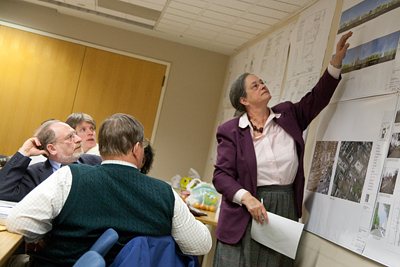 In other words, it’s a big building for the property. It’s so big that City Plan staff recommended that the north side be adjusted to create a side yard of at least 16 feet. It is now planned as eight feet wide at its narrowest, which “does seem very pinched,” said City Plan Director Karyn Gilvarg (at right in photo).
In other words, it’s a big building for the property. It’s so big that City Plan staff recommended that the north side be adjusted to create a side yard of at least 16 feet. It is now planned as eight feet wide at its narrowest, which “does seem very pinched,” said City Plan Director Karyn Gilvarg (at right in photo).
But, she added later, the building’s large dimensions “have to be taken in the context of what we’re getting — a unified building, of somewhat subjectively, high architectural quality.”
What’s more, Gilvarg said, since the plan calls for underground parking, existing parking lots can be converted to green space.
“The city has been encouraging Yale not to spread out” by buying more non-taxable property, Gilvarg said. The city has asked Yale to instead use what it already has. And that’s what Yale is doing.
“An Enormous Issue”
City Plan Commissioner and East Rock Alderman Roland Lemar was the first of a number of board members to worry aloud about Yale starting a project it can’t finish.
What if Yale takes the building’s down and there’s an “economic collapse” and the university can’t finishing building the new SOM? he asked.
Gilvarg responded with two suggested conditions of approval: One, that any “interim uses” of the site between demolition and construction be approved by the City Plan Commission. And two, that demolition shall not commence until Yale has the money to complete the project.
Commission Chair Ed Mattison liked the conditions. “This is really an enormous issue,” he said. “To blow a hole into that significant a part piece of Whitney Avenue” is not to be taken lightly.
Lemar said it’s important to “protect this neighborhood from a vacant site.”
Lemar and other commissioners mentioned other plan modifications that they’d like to see, including improvements to the bike and foot path from Pearl Street to Whitney Avenue and better tree coverage on the south side of the building. Commissioners agreed that these specific details could be discussed at future site plan reviews, after the project has been approved in general.
The board voted unanimously to approve the PDD application, with a number of conditions, including the two that Gilvarg suggested.
Design Debate
“I’m delighted that the City Plan Commission has moved this project forward,” said Morand, after the vote. The commission’s approval means that it found the building “meritorious,” Morand said.
He said Yale looks forward to working with aldermen and neighbors to “see how we can meet the spirit of the recommendations.” The details remain to be worked out, he said.
After working on the project for three years, Morand said he could not comment on the new conditions — heard only in the last three minutes — that would require funds in hand before construction begins. The School of Management has a great record of success raising money, he said.
He cautioned that requirements intended to speed up construction could actually slow the project down. For instance, if the Board of Aldermen requires 90 days minimum between demolition and construction, that could delay the start of demolition, since Yale would have to take more time to make the preparations to meet the 90-day deadline.
That’s not what neighbors want, Morand said, pointing to Richard Kane, who lives behind the site on Lincoln Street.
“I’d just as soon have no delays,” Kane said. “I’d like to have the building taken down while my windows are shut during the wintertime.”
Kane said the design of the SOM building is better than it could have been. “I’d rather it be longer and lower, than higher,” he said.
Other neighbors weren’t so sanguine. Joe Tagliarini, whose Bradley Street house borders the site, described the building style as “behemoth architecture in need of a whack on the head.”
Tagliarini just put a one-room addition onto his house. He said that project underwent far more scrutiny by building officials than Yale’s $145 million building proposal.
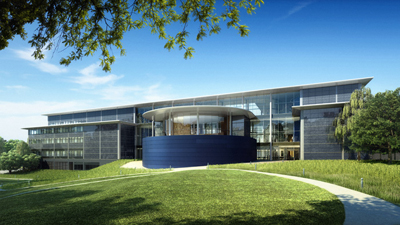 Andrew Drabkin, who also lives on Bradley Street, dismissed Kane’s argument that the design could have been worse. “Yeah, it could be worse, but it could be a lot better.” Kane’s Lincoln Street property will look out on the SOM building’s new terraced, landscaped backyard (pictured). But Bradley Street residents will have no such buffer, Drabkin said.
Andrew Drabkin, who also lives on Bradley Street, dismissed Kane’s argument that the design could have been worse. “Yeah, it could be worse, but it could be a lot better.” Kane’s Lincoln Street property will look out on the SOM building’s new terraced, landscaped backyard (pictured). But Bradley Street residents will have no such buffer, Drabkin said.
Tagliarini, whose house will be the closest on Bradley Street to the new building, said he will have to deal with the “fishbowl effect” of SOM students looking down into the pool in his backyard.
Tagliarini and Drabkin both termed the SOM building as simply too large for the neighborhood. They’re two of nearly 20 neighbors who wrote to the City Plan Commission to object to the SOM proposal.
Not only is the building too big, Tagliarini and Drabkin said; the design is unattractive. Commissioners should have addressed that, they said.
“They [the commissioners] walked right by one of their obligations,” said Anstress Farwell, head of the New Haven Urban Design League. “You have to deal with design.”
“An airport doesn’t belong on Whitney,” Farwell said.
“We are not architectural gurus,” said Mattison later, defending the commission’s lack of aesthetic discussion. “Given what we’ve approved on various occasions, this is not out of line.”
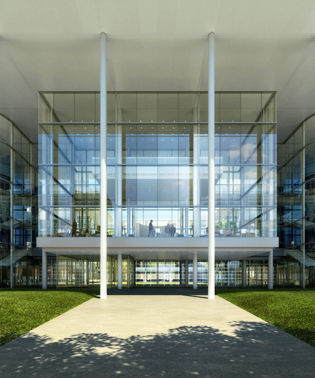 Gilvarg said the City Plan Department’s advisory report does tackle aesthetic questions. She offered a defense of the design. “The building in its shape and massing is fairly respectful to Whitney Avenue,” she said. The front of the building [pictured] presents a “modern version of a traditional collonade,” which “plays off of other buildings” on the street.
Gilvarg said the City Plan Department’s advisory report does tackle aesthetic questions. She offered a defense of the design. “The building in its shape and massing is fairly respectful to Whitney Avenue,” she said. The front of the building [pictured] presents a “modern version of a traditional collonade,” which “plays off of other buildings” on the street.
Gilvarg said she welcomes the design debate that has accompanied the SOM proposal. “That debate is a feature of the academic community,” she said. “It’s a positive factor of having Yale here.”
The school has a “tradition of being adventurous” when it comes to architecture, she said. And many of its adventurous plans cause controversy. But many are also later lauded. “How many hundreds of people come to visit the Yale whale every year?” she asked.






“How many hundreds of people come to visit the Yale whale every year?” she asked.
I'd be very eager to find out the answer to that question, and I'm not sure it would support Gilvarg's implied argument.